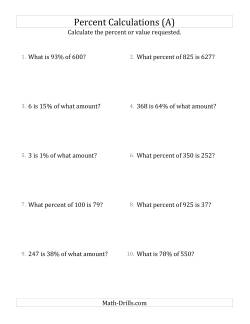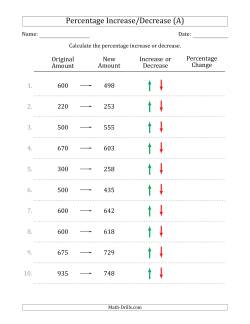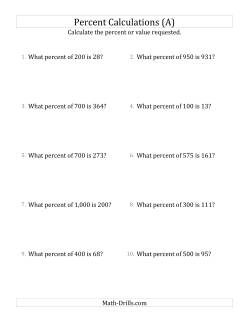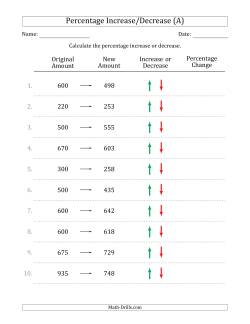Welcome to the percentages math worksheet page where we are 100% committed to providing excellent math worksheets. This page includes Percentages worksheets including calculating percentages of a number, percentage rates, and original amounts and percentage increase and decrease worksheets.
As you probably know, percentages are a special kind of decimal. Most calculations involving percentages involve using the percentage in its decimal form. This is achieved by dividing the percentage amount by 100. There are many worksheets on percentages below. In the first few sections, there are worksheets involving the three main types of percentage problems: calculating the percentage value of a number, calculating the percentage rate of one number compared to another number, and calculating the original amount given the percentage value and the percentage rate.
Most Popular Percentages Worksheets this Week





Percentage Calculations

Calculating the percentage value of a number involves a little bit of multiplication. One should be familiar with decimal multiplication and decimal place value before working with percentage values. The percentage value needs to be converted to a decimal by dividing by 100. 18%, for example is 18 ÷ 100 = 0.18. When a question asks for a percentage value of a number, it is asking you to multiply the two numbers together.
Example question: What is 18% of 2800? Answer: Convert 18% to a decimal and multiply by 2800. 2800 × 0.18 = 504. 504 is 18% of 2800.
-
Calculating the Percentage Value (Whole Number Results) (Percents from 1% to 99%) Calculating the Percentage Value (Whole Number Results) (Select percents) Calculating the Percentage Value (Whole Number Results) (Percents that are multiples of 5%) Calculating the Percentage Value (Whole Number Results) (Percents that are multiples of 25%)
-
Calculating the Percentage Value (Decimal Number Results) (Percents from 1% to 99%) Calculating the Percentage Value (Decimal Number Results) (Select percents) Calculating the Percentage Value (Decimal Number Results) (Percents that are multiples of 5%) Calculating the Percentage Value (Decimal Number Results) (Percents that are multiples of 25%)
-
Calculating the Percentage Value (Whole Dollar Results) (Percents from 1% to 99%) Calculating the Percentage Value (Whole Dollar Results) (Select percents) Calculating the Percentage Value (Whole Dollar Results) (Percents that are multiples of 5%) Calculating the Percentage Value (Whole Dollar Results) (Percents that are multiples of 25%)
-
Calculating the Percentage Value (Decimal Dollar Results) (Percents from 1% to 99%) Calculating the Percentage Value (Decimal Dollar Results) (Select percents) Calculating the Percentage Value (Decimal Dollar Results) (Percents that are multiples of 5%) Calculating the Percentage Value (Decimal Dollar Results) (Percents that are multiples of 25%)
Calculating what percentage one number is of another number is the second common type of percentage calculation. In this case, division is required followed by converting the decimal to a percentage. If the first number is 100% of the value, the second number will also be 100% if the two numbers are equal; however, this isn't usually the case. If the second number is less than the first number, the second number is less than 100%. If the second number is greater than the first number, the second number is greater than 100%. A simple example is: What percentage of 10 is 6? Because 6 is less than 10, it must also be less than 100% of 10. To calculate, divide 6 by 10 to get 0.6; then convert 0.6 to a percentage by multiplying by 100. 0.6 × 100 = 60%. Therefore, 6 is 60% of 10.
Example question: What percentage of 3700 is 2479? First, recognize that 2479 is less than 3700, so the percentage value must also be less than 100%. Divide 2479 by 3700 and multiply by 100. 2479 ÷ 3700 × 100 = 67%.
-
Calculating the Percentage a Whole Number is of Another Whole Number (Percents from 1% to 99%) Calculating the Percentage a Whole Number is of Another Whole Number (Select percents) Calculating the Percentage a Whole Number is of Another Whole Number (Percents that are multiples of 5%) Calculating the Percentage a Whole Number is of Another Whole Number (Percents that are multiples of 25%)
-
Calculating the Percentage a Decimal Number is of a Whole Number (Percents from 1% to 99%) Calculating the Percentage a Decimal Number is of a Whole Number (Select percents) Calculating the Percentage a Decimal Number is of a Whole Number (Percents that are multiples of 5%) Calculating the Percentage a Decimal Number is of a Whole Number (Percents that are multiples of 25%)
-
Calculating the Percentage a Whole Dollar Amount is of Another Whole Dollar Amount (Percents from 1% to 99%) Calculating the Percentage a Whole Dollar Amount is of Another Whole Dollar Amount (Select percents) Calculating the Percentage a Whole Dollar Amount is of Another Whole Dollar Amount (Percents that are multiples of 5%) Calculating the Percentage a Whole Dollar Amount is of Another Whole Dollar Amount (Percents that are multiples of 25%)
-
Calculating the Percentage a Decimal Dollar Amount is of a Whole Dollar Amount (Percents from 1% to 99%) Calculating the Percentage a Decimal Dollar Amount is of a Whole Dollar Amount (Select percents) Calculating the Percentage a Decimal Dollar Amount is of a Whole Dollar Amount (Percents that are multiples of 5%) Calculating the Percentage a Decimal Dollar Amount is of a Whole Dollar Amount (Percents that are multiples of 25%)
The third type of percentage calculation involves calculating the original amount from the percentage value and the percentage. The process involved here is the reverse of calculating the percentage value of a number. To get 10% of 100, for example, multiply 100 × 0.10 = 10. To reverse this process, divide 10 by 0.10 to get 100. 10 ÷ 0.10 = 100.
Example question: 4066 is 95% of what original amount? To calculate 4066 in the first place, a number was multiplied by 0.95 to get 4066. To reverse this process, divide to get the original number. In this case, 4066 ÷ 0.95 = 4280.
-
Calculating the Original Amount (Percents from 1% to 99%) (Whole Numbers) Calculating the Original Amount (Select percents) (Whole Numbers) Calculating the Original Amount (Percents that are multiples of 5%) (Whole Numbers) Calculating the Original Amount (Percents that are multiples of 25%) (Whole Numbers)
-
Calculating the Original Amount (Percents from 1% to 99%) (Dollar Amounts and Whole Numbers) Calculating the Original Amount (Select percents) (Dollar Amounts and Whole Numbers) Calculating the Original Amount (Percents that are multiples of 5%) (Dollar Amounts and Whole Numbers) Calculating the Original Amount (Percents that are multiples of 25%) (Dollar Amounts and Whole Numbers)
-
Calculating the Original Amount (Percents from 1% to 99%) (Dollar Amounts and Decimals) Calculating the Original Amount (Select percents) (Dollar Amounts and Decimals) Calculating the Original Amount (Percents that are multiples of 5%) (Dollar Amounts and Decimals) Calculating the Original Amount (Percents that are multiples of 25%) (Dollar Amounts and Decimals)
-
Mixed Percentage Calculations (Percents from 1% to 99%) (Whole Numbers) Mixed Percentage Calculations (Select percents) (Whole Numbers) Mixed Percentage Calculations (Percents that are multiples of 5%) (Whole Numbers) Mixed Percentage Calculations (Percents that are multiples of 25%) (Whole Numbers)
-
Mixed Percentage Calculations (Percents from 1% to 99%) (Dollar Amounts and Whole Numbers) Mixed Percentage Calculations (Select percents) (Dollar Amounts and Whole Numbers) Mixed Percentage Calculations (Percents that are multiples of 5%) (Dollar Amounts and Whole Numbers) Mixed Percentage Calculations (Percents that are multiples of 25%) (Dollar Amounts and Whole Numbers)
-
Mixed Percentage Calculations (Percents from 1% to 99%) (Dollar Amounts and Decimals) Mixed Percentage Calculations (Select percents) (Dollar Amounts and Decimals) Mixed Percentage Calculations (Percents that are multiples of 5%) (Dollar Amounts and Decimals) Mixed Percentage Calculations (Percents that are multiples of 25%) (Dollar Amounts and Decimals)
Percentage Increase/Decrease Worksheets

The worksheets in this section have students determine by what percentage something increases or decreases. Each question includes an original amount and a new amount. Students determine the change from the original to the new amount using a formula: ((new - original)/original) × 100 or another method. It should be straight-forward to determine if there is an increase or a decrease. In the case of a decrease, the percentage change (using the formula) will be negative.
